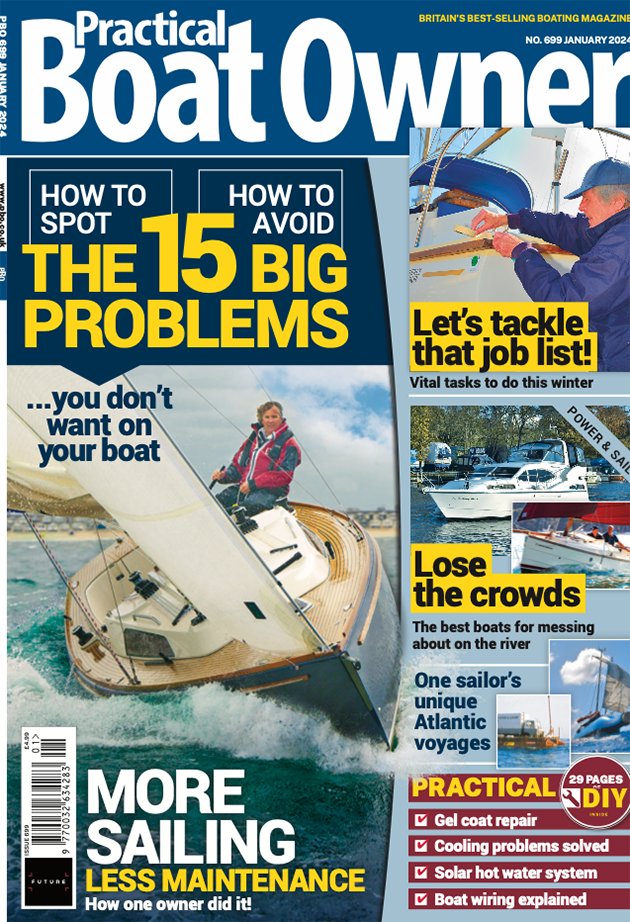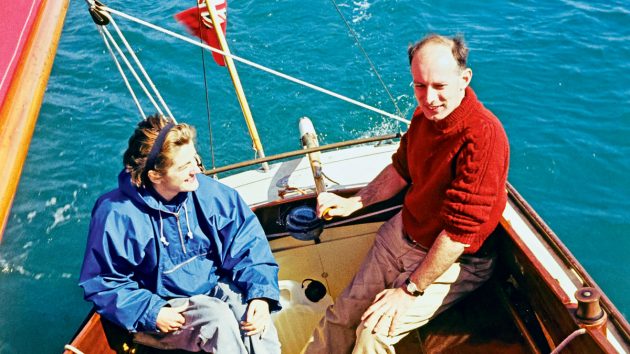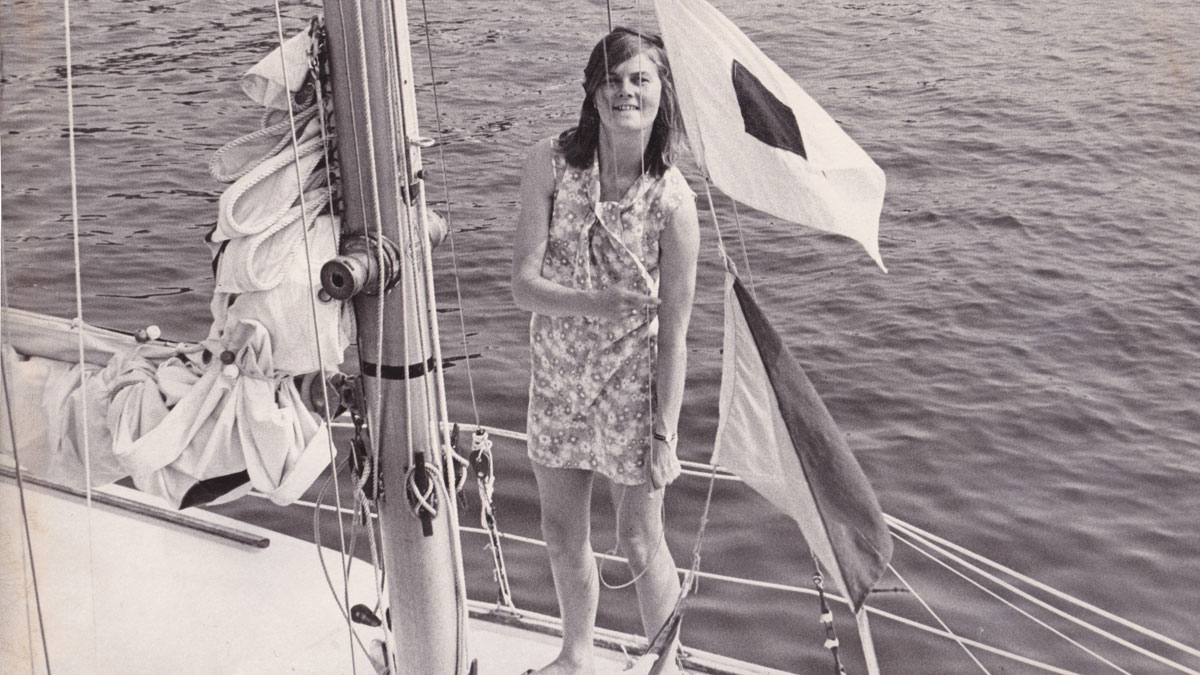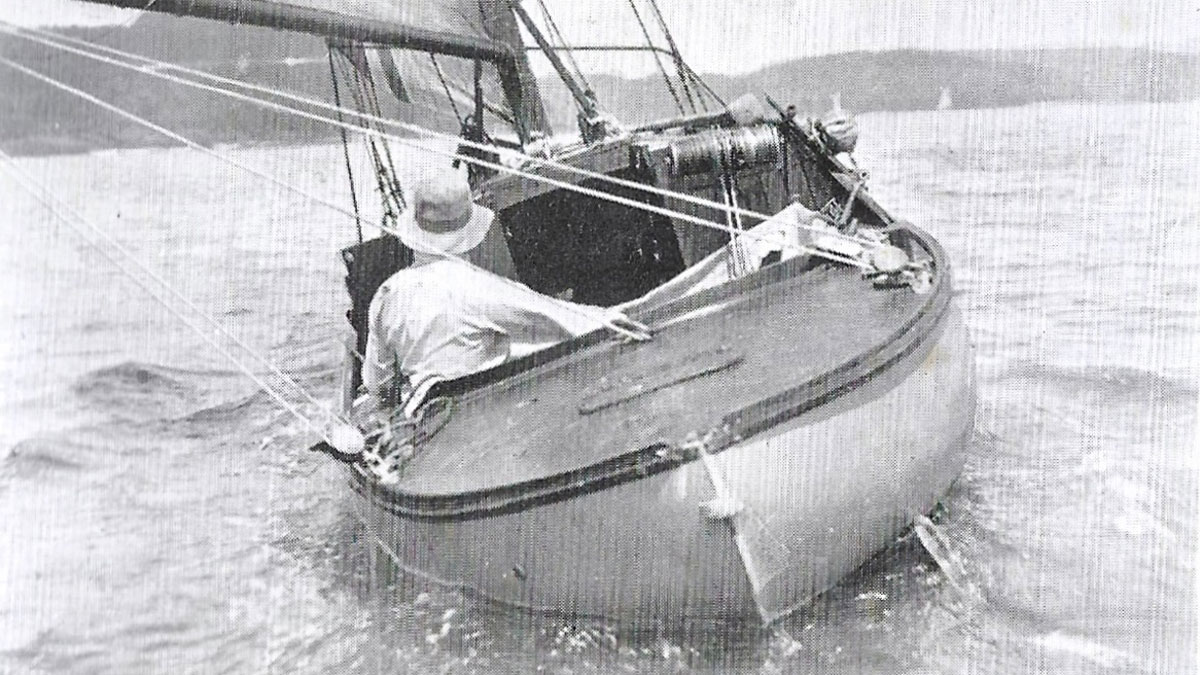Genevieve Leaper shares her late father John Leaper’s recollections – compiled from handwritten notes – of cruising the Channel in his Shearwater sloop during the 1960s
For our honeymoon in June 1962, Mary and I decided to go touring and give sailing a rest.
But we missed the sea and when my father-in-law’s cruising yacht became ready for collection, we cut our special holiday in Cornwall short to help him sail Wataita home from Poole, Dorset, to Chichester Harbour.
Wataita was a Dell Quay Shearwater, a 22ft cold-moulded plywood sloop of 1.5 tons displacement and 4ft draught with centreboard down.
Borrowing the boat later that summer for a short trip, Mary – a keen dinghy sailor – had her appetite for cruising thoroughly whetted and I found the responsibility of skippering much more satisfying than the navigating and watchkeeping I had done before with the Island Cruising Club.
That winter we made plans for a longer cruise.

Mary on board Shearwater boat, Wataita, Yarmouth, Isle of Wight, 1962. Credit: John Leaper
I made a chart table, acquired the charts to go with it and borrowed a pilot book. Navigation equipment consisted of steering and hand-bearing compasses.
I considered a log to be essential for crossing Lyme Bay or the Channel but it was an expensive item at over £20.
Having the line and rotator already, I decided to make one myself.
The design involved a magneto ball bearing, a Woolworths plastic food container, Meccano gears and a Lucas cyclometer held together with Araldite (total cost 25 shillings).
A leadline was easily made with a fishing weight; it was to prove adequate for anchoring but too light to use under way.
The meth stove was stowed under a cockpit seat and pulled out over one of the bunks.
Cooking at sea would be difficult as it wasn’t gimballed, so two large vacuum food flasks were purchased.
Extended voyage
On 19 May 1963, Wataita left her Hayling Island mooring at 1600, beating into a westerly wind. It took five hours and many tacks to reach Wootton Creek.
The next day was no easier with a strong westerly wind, occasional drizzle. We only saw two other sailing boats.
By lunchtime we had arrived in Lymington where the New Forest ponies grazed on the town’s grass verges.
The wind howled in the rigging overnight, but Wataita set off with our customary rig of No1 jib and reefed main in the morning to catch the first of the tide through the Needles Channel. It was still a beat.
The log was streamed but calibration was a problem with strong tidal currents. I later realised it under-read by about 25%.
Entering Poole Harbour against full spring ebb, the wind freshened with Force 6 or 7 squalls.

Kit and Letty Scruton (Mary’s parents) sailing the Shearwater boat, Wataita in Chichester Harbour. Credit: John Leaper
Surging on the face of the steep waves enabled us to inch our way past the Swash Channel marker buoys.
After a quiet night anchored off Brownsea Island, we crossed to Poole Yacht Club jetty for water, shopping and petrol.
By midday we were out of the harbour but soon becalmed.
Later, the tide swept us through the Peveril Ledge race – about 15 standing waves, some 3ft high and very steep-faced, occasionally breaking at the crest though there wasn’t a breath of wind – a little motoring was required to clear St Alban’s Head.
Finally a freshening north-westerly allowed for a good sail.

Mary on board the Shearwater boat, Wataita. Credit: John Leaper
Approaching Portland Harbour a minesweeper overtook us and we were so busy discussing the significance of the gear she was towing that we forgot to dip our ensign.
The Sailing Directions gave complicated instructions about the signals displayed for entering Portland.
Looking directly into the sun we couldn’t identify the signal station, let alone the signals, so we just sailed on.
Just as we shaped up to pass through the east gap a landing craft appeared so we had to do a quick tack.
Having picked up a mooring belonging to the Naval Sailing Association, I rowed ashore and was put through on the phone to the Officer of the Watch who gave permission to stay the night.
It was an uncomfortable one with a two mile fetch across the harbour as the wind shifted to north-east.
Nauseating fumes
Next morning was overcast, drizzly, with sufficient wind and waves to make life cold and uncomfortable.
I topped up the main petrol tank but with the motion I spilled enough fuel to cause a strong smell and came the closest to being seasick of the whole cruise.
The notorious tidal race off Portland Bill was avoided by passing well offshore at the turn of the tide and it was an uneventful passage across Lyme Bay.
Apart from warships near the Bill, from then until landfall we saw only one steamer, a fishing boat and a yacht bound eastwards.

Trawlers in Brixham harbour, May 1963. Credit: John Leaper
We sighted the Exmouth coast in the evening before watching a vivid red sun set in the grey gloom.
Only then could a positive fix be obtained from the lights of Berry Head and Teignmouth.
Approaching Brixham close to midnight the sails were stowed and the log taken in. About 50 yards short of the breakwater the engine cut out without warning.
Continues below…
How sailing gear has changed over the decades
Peter Poland reflects on pulling out the lead line, lobbing a Walker log over the stern and unpacking a sextant…
The pioneering sailor you’ve probably never heard of: Nicolette Milnes Walker
Nicolette Milnes Walker was the first woman to sail solo and non-stop from the UK to the USA. Julia Jones…
Margaret and Frank Dye: open boat pioneers
Roger Barnes reflects on the legacy of small-boat sailors Margaret and Frank Dye
Frank Cowper: the sailor who “invented” cruising
Katy Stickland talks to Frank Cowper’s great granddaughter about the life and legacy of this unsung pioneer of yachting for…
Luckily there was only the faintest of westerly airs blowing us out to sea. After three or four tries at restarting I decided to tow her in with the dinghy.
After about 10 minutes I had made up the ground we had lost and Mary managed to start the engine.
I changed the sooted spark plug the next morning. I probably should have done that earlier, but then I would have missed the view of the yacht from low down under the bows with her navigation lights shining and the town lights just illuminating the hull and mast.

Brixham Yacht Club, Brixham Harbour, May 1963. Credit: John Leaper
We were woken at 0900 by the yacht club launch – having unfortunately chosen the one mooring that was needed.
Later one of the boatmen told me of going to sea in the sailing trawlers at 11 years old – the normal thing for Brixham boys in those days.
It was such a lovely afternoon we went for a sail around Torbay.
A fish and chip supper ashore was followed by drinks at the Brixham Yacht Club, one of the most hospitable imaginable to cruising people.
Happy memories of cruising our Shearwater boat
Mary remembers the days in Devon as the best part of the cruise.
With a light breeze and fair tide it was a gentle sail round to Dittisham on the River Dart, which was beautiful in the sunshine.
After a leisurely breakfast, we explored the upper reaches of the Dart. We had not meant to go far but as each stretch came into view there was always another bend to entice us on.
Here, we found an Ordnance Survey map much more useful than the Admiralty Chart.
Eventually the river valley became rather flat and straight and it was slow work against the ebb so we turned round with the roofs of Totnes clearly visible.

The Shearwater boat, Wataita is launched at the start of the season, Hayling Island. Credit: John Leaper
Progress suddenly became much more rapid; past the couple fishing, a paddle steamer wreck, the shelducks and swans on the grassy banks, the large country house and the nude sunbather secluded on the wooded shore.
With only a fortnight’s holiday, it was time to think about getting back. The 1800 Shipping Forecast was north-easterly Force 3 increasing to Force 4-5.
The possibility of a beat to Portland Bill was all the justification I needed to head for Alderney instead – a passage of 65 miles.
Thirty five minutes later we were on our way. Light fickle winds for a few hours settled into a broad reach with full sail.

John Leaper at the helm, sailing Wataita. Credit: Kit Scruton
While it was calm we had a meal of stewed steak, cooked in the vacuum jar – just the thing to precede an all night sail.
After midnight steamers appeared from several directions and one boat changed course and headed straight at us.
We shone our most powerful torch alternately at him and on the sail until we received an answering wink from a signal light and he altered course.
The rest of the night was quiet and in the morning we continued steadily across the empty sea.
By 1200 we had run the correct distance by the log and each of us was anxiously searching the horizon for a glimpse of land.
Away to starboard one spot had more substance so we changed course towards it. The island appeared rapidly, showing that visibility was actually worse than we had realised.
An hour later Wataita anchored close to the inner harbour entrance.
Walking up to the town of St Anne, we bought really fresh creamy milk at the dairy and later splashed out on a five course meal at a hotel recommended by the friendly harbourmaster.
Homeward bound
The next couple of days, the weather turned cold and murky with a north-east wind – the worst direction for Braye Harbour.
After a sleepless night in a heavy swell, the forecast was still north to north-easterly Force 5-6 with poor visibility.
There was no question of setting out with a 60-mile beat. Even getting ashore was difficult, the only option being a vertical ladder in the inner harbour where the glassfibre dinghy got badly scratched.
The evening forecast was slightly better and it was a relief to leave for Poole at 2000, even into headwinds and drizzle.

Pen and ink drawing of Shearwater boat, Wataita by John Leaper
Conditions improved and we were nearly able to sail our course.
It was the coldest night’s sailing I have ever had and we each stood watch until we couldn’t stand it any longer.
The first land sighted at 0935 was Portland Bill, so we went about immediately to sail eastwards.
Tacking again when the log indicated the right distance, then St Alban’s Head appeared as expected. Off Swanage the weather changed from being overcast and very cold to swelteringly hot sunshine.

Mary watches from the beach as her parents sail their Shearwater boat, Wataita at Chichester entrance. Credit: John Leaper
We could hardly take off our oilskins and sweaters fast enough.
Arriving in Poole harbour the Q flag was duly hoisted.
Out of all the preparations for the cruise, the purchase of the Q flag had an importance out of all proportion to size.
But, after an hour at anchor, I began to wonder if anyone would notice my yellow flag. The customs launch did eventually arrive; two officers came on board and filled the cabin.
Back in the Solent, it was hard going again against a fresh easterly wind.
From Newtown, by far the most unspoilt anchorage in the Solent, we gave up trying to get to Chichester and sought refuge in Portsmouth for the night.

John Leaper (1933 – 2016) taught himself to sail in a dinghy on Southampton Water. He was an engineer, working at the Admiralty Research Laboratory when he met his wife-to-be, Mary Scruton, at Hayling Island Sailing Club. Their daughter Genevieve grew up sailing. She has a zoology degree and has worked on seabird and marine mammal surveys. A photographer, writer and environmental consultant, Genevieve owns a 17ft trimaran but mostly sails on her partner Aleko’s Nicholson 32 in Greece.
Well-reefed and beating again, we motor-sailed the last 8 miles home.
Our difficulties were not over back on the mooring at Hayling Island; the wind was freshening rapidly and the strong ebb held the boat exactly beam on to wind and waves.
Wataita was just about rolling her gunwales under, we had to pretty well abandon ship and leave getting gear ashore for another occasion.
Genevieve adds: They were not put off – though my mother admits she was relieved to get home.
Plans for cruising the following year were scuppered by the arrival of their first child (me!).
However, it wasn’t long before my father bought a 25ft plywood trimaran, which was followed by a Westerly Centaur and Westerly Konsort.
The Shearwater was the start of a lifetime of cruising; with the family to the Isles of Scilly, Channel Islands and north Brittany, after retirement on the west coast of Scotland.
Having started small, John and Mary never felt the need for a bigger boat than the 29ft Konsort which they owned for more than 40 years.
Enjoyed reading 1960s cruising in a Shearwater boat? 
A subscription to Practical Boat Owner magazine costs around 40% less than the cover price.
Print and digital editions are available through Magazines Direct – where you can also find the latest deals.
PBO is packed with information to help you get the most from boat ownership – whether sail or power.
-
-
-
- Take your DIY skills to the next level with trusted advice on boat maintenance and repairs
- Impartial in-depth gear reviews
- Practical cruising tips for making the most of your time afloat
-
-
Follow us on Facebook, Instagram, TikTok and Twitter








